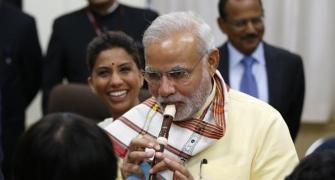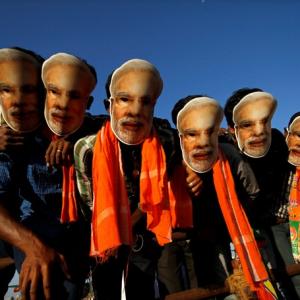It's crucial for Modi to make India an easier place to do business, but the RBI, too, has to perform a balancing act, notes Andy Mukherjee.

Photograph: PIB
The Reserve Bank of India (RBI) has been unexpectedly stingy with interest-rate cuts.
This has annoyed businessmen, investors and even some government officials.
They are all miffed with what they see as too great an emphasis on controlling non-existent inflationary pressures at the expense of too large a growth sacrifice.
But going beyond the short-term pain, it’s time to ask if the central bank is preparing the economy for less stimulus-led, more enduring future growth, or whether its version of parental tough love will do more harm than good even in the long run.
Over the past year, RBI Governor Raghuram Rajan has cut the benchmark repurchase rate by 0.75 percentage point to 7.25 per cent. He might deliver another quarter percentage point reduction today.
But consumer price inflation in the same period has slowed by almost three percentage points to 3.7 per cent. Inflation-adjusted real policy rates in India have shot up to almost 3.6 per cent, after being largely negative since 2007.
The monetary policy overkill offers the distinct benefits of permanently lower inflation and an earlier-than-expected opening up of the capital account, but these advantages are overshadowed by the price that higher-than-warranted interest costs threaten to extract from the economy: a structurally high unemployment rate.
Like many economies around the world, India, too, is staring at a jobs crisis.
The news that PhDs are competing for peons’ jobs and call-centre employees are becoming Uber drivers shouldn’t be a surprise even in an economy expanding at an annual seven per cent rate — a number few investors actually believe.
The unemployment problem has its root in education. In 2005, about 30 million youth in the age group of 15 to 24 years were attending schools, colleges and polytechnics.
By 2010, that number had doubled to 60 million. In recent years, this bigger cohort of more educated youth has started entering the workforce. But at the same time, the pipeline of jobs that these new entrants have been hoping to land has all but dried up.
Private investment is sluggish. Export demand is horrendous, and the already-large slack of unused capacity in India can only swell as China’s economy slows further, putting pressure on Beijing to further cheapen its currency and flood global markets with surplus Chinese production.
Meanwhile, Brazil and Russia are already in recession, Japan and Europe are struggling, and policymakers in the United States are far from sure if the world’s biggest economy is ready for its first increase in interest rates in eight years.
Citigroup estimates a 55 per cent likelihood of a global recession between 2016 and 2018. If India leaves job creation on the to-do list until the world economy is on a firmer footing, it will be time for the next general elections.
By then, the political class would be at risk of being overwhelmed by demands for caste-based jobs reservation - perhaps even in the private sector. Companies will respond by automating processes and hiring robots.
Contrast this threat of a structurally higher unemployment rate against the benefits of keeping borrowing costs higher than they should be.
First, with the central bank intent on wringing the economy dry of price pressures, there is now a chance, according to Nomura, that RBI will shift its focus from an inflation target of six per cent by January next year to five per cent by early 2017.
If the soon-to-be-announced monetary policy committee sticks to Rajan’s script, inflation expectations could get lowered permanently, wage pressures would ebb, and interest costs might be lower for future businessmen and homebuyers.
Indian exports will become more competitive. Low-income groups will have more control over their household budgets.
Add-on benefits will be an earlier-than-expected embrace of a fully convertible rupee, and greater fiscal discipline.
Once capital controls on resident Indians lift, New Delhi won’t be able to borrow limitlessly; the government will have to compete for household savings.
If inflation expectations are volatile, the cost of financing public expenditure could be higher under a full convertibility. But if the RBI is able to convince savers that inflation will stay on target, then they might be willing lenders to the government at lower interest rates than now.
These gains from a permanent victory against inflation are hardly insignificant.
Yet higher-than-acceptable unemployment is too big a price to pay: India is better off being a productive, fast-growing emerging market first; becoming a First World economy can wait.
But can monetary policy really spur employment? Multiple studies have shown that for every one per cent GDP growth, India now creates fewer jobs than in the 1970s.
So even if the RBI manages to lift growth, India may not get all the jobs it wants.
That’s why it’s crucial for Prime Minister Narendra Modi to fix the country’s predatory and fragmented tax system, unshackle land, labour, capital and product markets, and make India an easier place to do business.
But the RBI, too, has to perform a balancing act. If monetary conditions are too lax, the government will be off the reform hook; if they are too tight, Team Modi won’t have much to show for its efforts.
A better trade-off may be to slash interest rates more boldly now to stoke private investment and create jobs. Some of this investment might turn out to be wasteful in a few years.
But if by then India has an efficient bankruptcy process and better-run public sector banks, it would be fairly easy to extricate productive capital from dying firms and put it to new use.
Most importantly, situations in which unemployed youth never find formal work, aren’t allowed to develop skills or build networks, and are thus reduced to the ranks of unemployable would be minimised.
There are risks to bolder monetary easing. A 14 per cent shortfall in monsoon rains could put pressure on food prices early next year. When the Federal Reserve does raise rates, the rupee might depreciate further against the dollar, making imported goods costlier.
Yet these risks are not showstoppers. There is little chance of the RBI missing its immediate goal of six per cent inflation.
And given just how bad the unemployment situation is, this isn’t the time to bring a harsher five per cent target into the monetary policy cross hairs.
The author is a Singapore-based financial journalist. The opinions expressed are his own.










